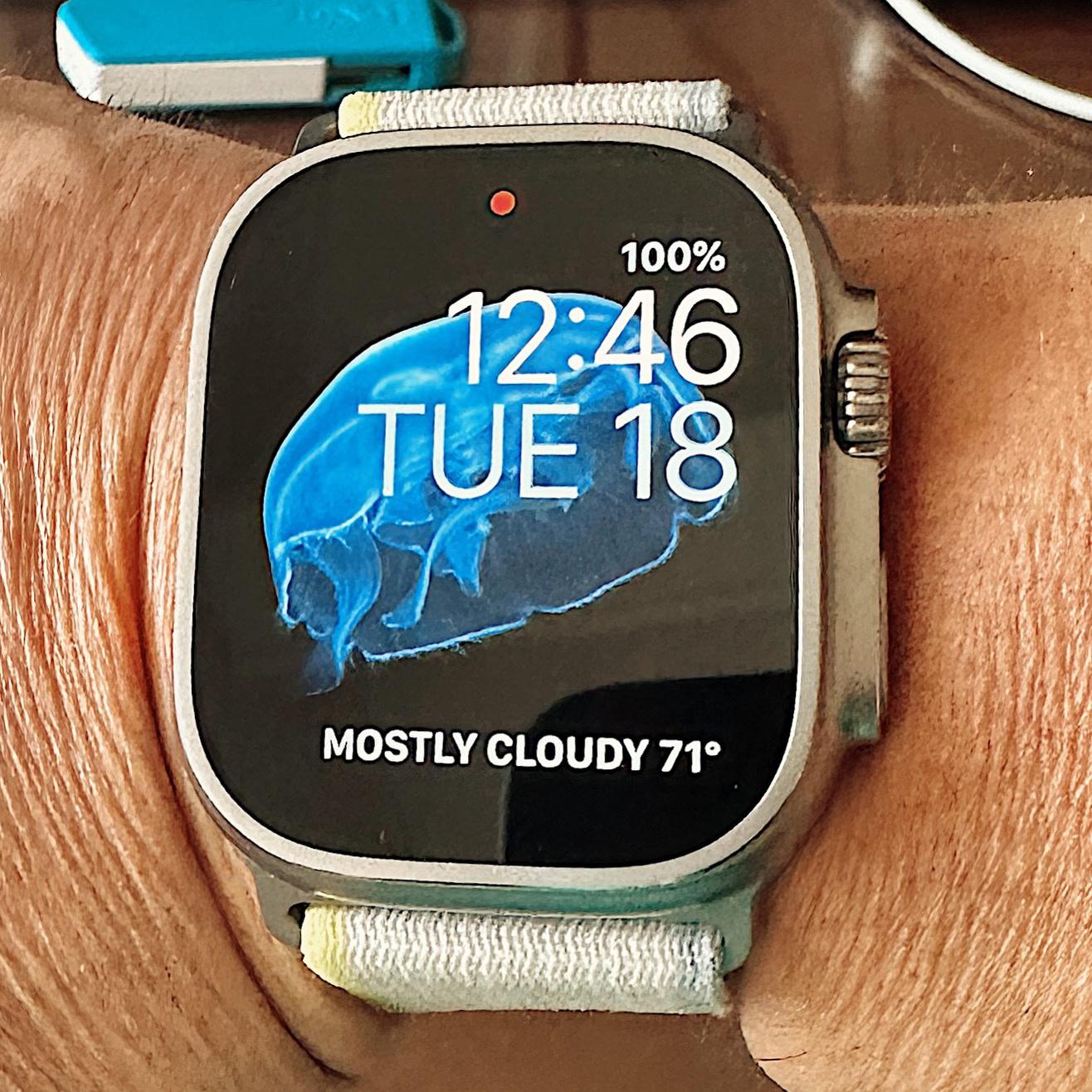
Apple Watch Ultra’s display is ultra big.
First, a confessional that neatly ties into the rest of this piece.
One of my New Year’s resolutions for 2023 is to not take on more pitches than I can turn around into a reported, written story in a reasonable time. However wildly successful this column has been over the past year, I can’t ignore the tension that comes from trying to juggle so many good projects at once. After all, the newsroom in these parts is staffed by literally one person: Steven. It’s impossible to assign my work to anyone else, so as to delegate and lighten the load. Despite the stratospheric successes my professional life has seen over the last year, the truth is I’m going to start the new year by publishing work that is literally so last year. There’s surely something to be said for accessibility and assistive technologies being evergreen topics; still, tardiness in the news game is bad.
My review of the Apple Watch Ultra is one of those pesky stragglers.
Apple sent me a review unit following their September event, at which the Ultra was officially introduced. I’ve worn it nearly every day since the device showed up on my doorstep in mid-October. In a word, Apple Watch Ultra is amazing. In a sentence, switching to the bigger and badder Ultra reminds of years ago when I switched to the similarly-spirited iPhone Plus model and never looked back.
Apple’s Marketing Goes Only So Far
Apple is positioning the Apple Watch Ultra as the ultimate smartwatch for extreme athletes like divers, marathon runners, hikers, and more. It’s reasonable to assume the device isn’t for mere mortals who just want to monitor their health and have a satellite device for things like phone calls, text messages, and other notifications. Not to mention that, priced at $799, the Ultra is also ultra expensive.
Apple’s product marketing teams aren’t rostered with dummies; they have to target this high-end Apple Watch at somebody. Yet it would be foolish to take Apple’s marketing copy at face value. The Apple Watch Ultra is desirable to a far broader swath of customers than simply the aforementioned hardcore adrenaline junkies. The simple reason—perhaps the main one on a device as small as an Apple Watch—is the big screen. At 49mm, it’s markedly larger than even the 44mm and 45mm models, let alone the OG 38mm and 42mm sizes of yore. Most people would call it convenient to have the Ultra’s big display, but as ever, accessibility trumps convenience every single time. The people who are going to reap the most practical benefit from Apple Watch Ultra isn’t a marathoner or a diver; it’s the visually impaired person who likes Apple Watch but wishes they could see it better, even with watchOS’s robust support for Dynamic Type.
MORE FOR YOU
So yes, Apple’s marketing blitz tells only half the story. The other half, the accessibility half, is an important part of the Apple Watch Ultra’s story too.
What Max is to iPhone, Ultra is to Apple Watch
At a fundamental level, Apple Watch Ultra and the iPhone Plus/Max models share the same axiom: bigger is better. On both, a bigger screen (and oftentimes bigger capabilities) means a bigger window into one’s content at the expense of ergonomics. It’s a lot like a Faustian bargain but technological—you can have a large screen for all that content, but there are costs. An Apple Watch Ultra and/or iPhone Max will be unwieldy objects that will cost your checkbook a lot more.
As a card-carrying member of the Giant iPhone Club, the appeal of the Apple Watch Ultra was immediately obvious. It wasn’t its capabilities that captivated; it was all about that ginormous display that won my heart. The display on the Ultra gives me the same feeling of joy I get from my iPhone 14 Pro Max: fumbling with an aircraft carrier of a phone is worth it if it means gaining access to that enormous screen. Even as someone with visual and motor disabilities, it feels only right to prioritize my vision above anything else given my phone is the lifeblood of my digital being. Moreover, it’s also for this reason that I religiously insist on upgrading my phone every year. It’s obviously important for journalism’s sake too, but even more a testament to how pivotal the smartphone is to my everyday life.
This same rationale applies to Apple Watch Ultra. Perhaps it isn’t necessary to get a new one every year, but the functional lesson remains the same. Getting the Ultra for its big screen alone is a worthwhile investment despite its heft, both tactilely and monetarily. It’s still small… it isn’t a device you want to use for extended periods. It’s precisely why the Ultra’s screen is so awesomely alluring.
New Bands, Old Problems
Apple included two of the Ultra’s new bands in my review kit: a white Ocean band and an orange Alpine Loop. Both were inaccessible for me to put on independently; the company later sent a yellow Trail Loop, which is eminently more accessible and the band I continue to use on the daily months later.
Band accessibility is an undervalued aspect of the Apple Watch experience, Ultra or otherwise. It’s taken for granted—even by Apple—that customers should be easily able to manipulate the various bands. The reality, however, is people with fine-motor delays (such as myself) can and do struggle mightily with different types of fasteners. Securing the Alpine and Ocean bands, for example, takes a level of dexterity and hand-eye coordination that I just don’t possess. By contrast, the it-isn’t-called-Velcro-but-it’s-Velcro strap of the Trail Loop is easy for me to slip on my wrist and pull to my desired fit. The same goes for taking it off at night.
To be clear, it’s not Apple’s fault the Ultra’s new bands are inaccessible. They’re exquisitely designed for what they’re supposed to be; it’s simply the bands don’t play nicely with me. Nonetheless, this should serve as a reminder to everyone, regardless of their ability level, that an Apple Watch does zero good if you fail to get it on your wrist without a struggle. Not everyone has the skills—or the patience—to fiddle with certain fasteners. Bands like the Trail Loop, and their cousin in the Sport Loop, are my favorites because of how pleasurable they are to get on and off. It just goes to show that the accessibility of Apple Watch (or any other Apple product) goes way beyond the ones and zeroes of an operating system’s software.
Finally, a related cursory note on the Ultra’s packaging. Faithful readers may recall in the last few Apple Watch reviews that I’ve bemoaned Apple’s choice to package the device piecemeal instead of as an “all-in-one” entity. The company has forged further on that path with the Ultra, shipping the case and the band as bespoke elements. While it makes complete sense from an operational efficiency standpoint, it’s a bad one in terms of accessibility. It’s the only Apple product, save for the Pro Display XDR’s $1000 stand, where you have to assemble it to use it. The issue is the same: not everyone has the competency with regards to hand-eye coordination to easily attach the band to the case and then get it on their wrist.
Again, an understandable win for Apple’s Operations teams, but an unfortunate loss for the rest of us with lackluster physical motor abilities. And that’s not even mentioning the cognitive load associated with having to figure out how to merge the two parts. All told, the piecemeal packaging adds undue friction to an experience that should otherwise be extremely exciting for everyone.
The Action Button
One of the Ultra’s headlining features is what Apple calls the Action button, a giant, rectangular orange button on the left side of the watch. (The company says the specific shade of orange is International Orange, which famously is used on the Golden Gate Bridge.) It essentially acts as a shortcut launcher; in the Watch app on iOS, you can set the button to trigger a variety of, well, actions: workout, stopwatch, waypoint, backtrack, dive, flashlight, a Shortcut, or tell it to do nothing. Press and hold the Action button, and a siren will start. It’s supposedly quite loud: it’s 86dB and can be heard from 500 feet away, according to Apple.
Apple has made an API available to app developers such that the Action button can be further customized. One obvious area would be accessibility, where a person could press the button to quickly toggle VoiceOver or whatever.
It’s a nice feature, but after inadvertently triggering it so many times in my testing, I’ve been tempted to disable the Action button altogether out of sheer annoyance.
The Bottom Line
Apple Watch Ultra is the best Apple Watch ever made, and not for all the reasons Apple says it is. It’s the ultimate Apple Watch. It’s a natural complement to my iPhone 14 Pro Max and easily my favorite product from Apple in the last year.
The best Apple Watch ever made is also the most accessible too. Count me as a proud member of the Apple Watch Ultra Club from here on out.






